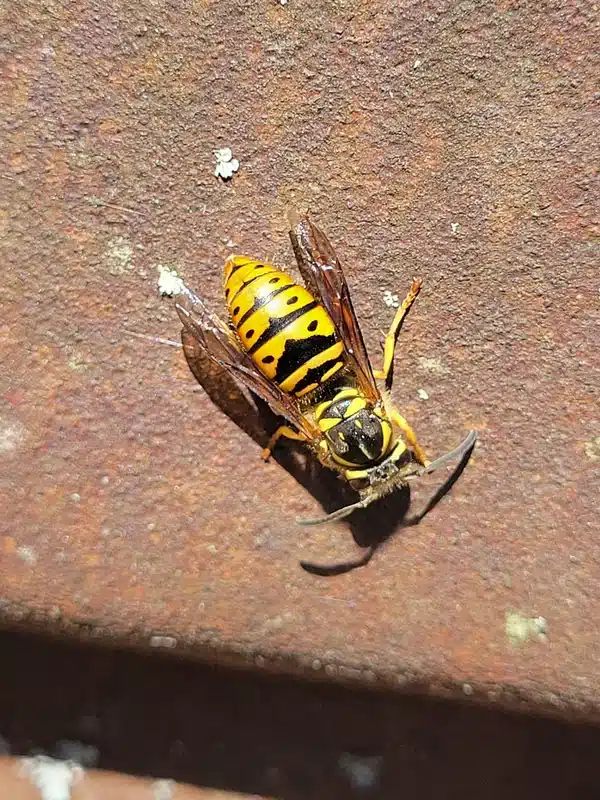When you spot a buzzing insect around your Virginia or Maryland home, knowing whether it’s a yellow jacket vs paper wasp can make all the difference. These two stinging insects look similar at first glance, but they have distinct behaviors, nesting habits, and levels of aggression that every homeowner should understand.
Both yellow jackets and paper wasps belong to the same family of social wasps, but their differences go far beyond appearance. Understanding these distinctions helps you make informed decisions about removal and appreciate their beneficial roles in your yard’s ecosystem.

Physical Differences: Yellow Jacket vs Paper Wasp Identification
The easiest way to distinguish between these insects is by examining their body structure and coloring. Yellow jackets have a stocky, compact build with a very short “waist” between their thorax and abdomen. They measure about 3/8 to 5/8 inch long, with bright yellow and black stripes covering their bodies.
In contrast, paper wasps appear more slender and elongated, typically measuring 3/4 to 1 inch in length. They have a pronounced “wasp waist” and longer legs that dangle noticeably during flight. Most paper wasp species in our region display reddish-brown coloring with yellow bands, though the invasive European paper wasp can mimic yellow jacket coloring.
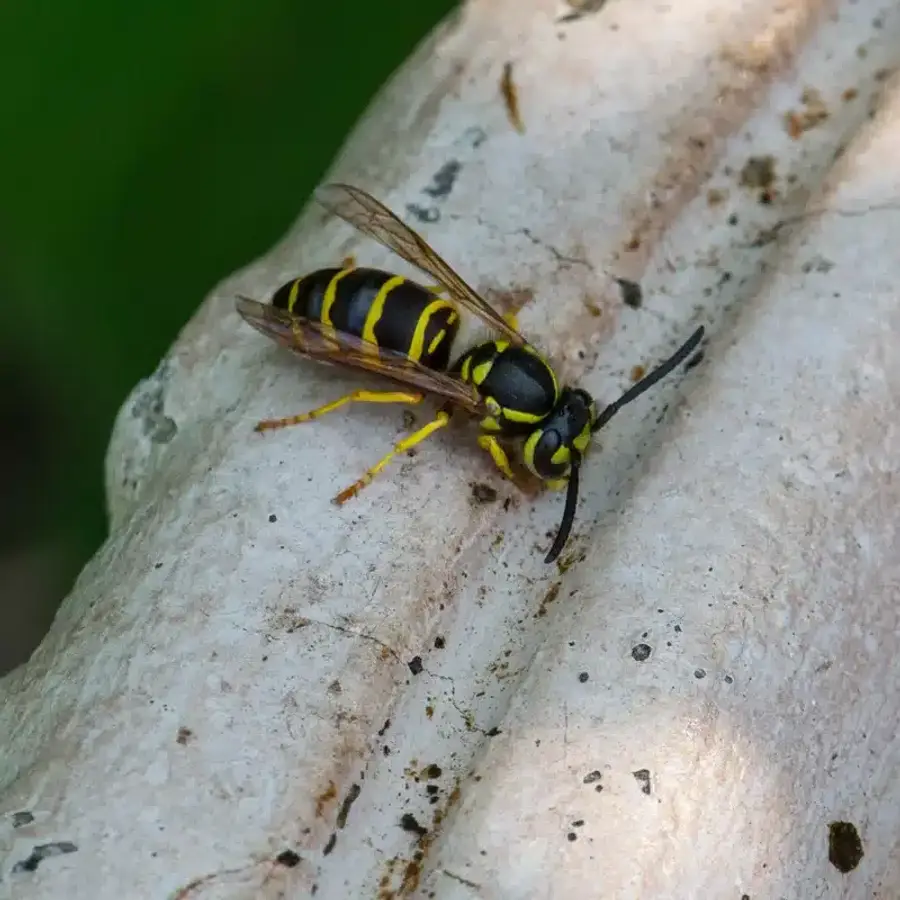
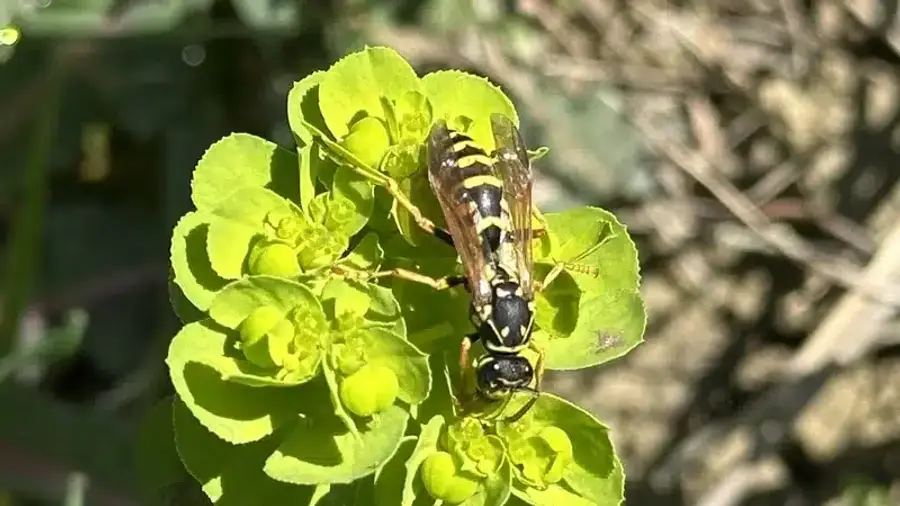
One key identifier for the European paper wasp is its orange antenna bases, which help distinguish it from true yellow jackets. During my years as a licensed pest control technician, I’ve found this detail particularly useful when homeowners describe “yellow and black wasps” around their property.
| Feature | Yellow Jacket | Paper Wasp |
|---|---|---|
| Body Shape | Stocky, compact build | Slender, pronounced waist |
| Size | 3/8 to 5/8 inch | 3/4 to 1 inch |
| Colors | Bright yellow & black | Reddish-brown & yellow |
| Nest Type | Enclosed paper envelope | Open umbrella-shaped |
| Nest Location | Underground or wall voids | Eaves, branches, fixtures |
| Aggression Level | Highly aggressive | Moderately defensive |
Nest Construction and Location Differences
The yellow jacket vs paper wasp comparison becomes even clearer when you examine their nesting habits. These insects create vastly different structures in completely different locations around your home.
Yellow Jacket Nests
Yellow jackets build enclosed, multi-tiered paper nests covered by a protective envelope. Most species nest underground in abandoned rodent burrows or cavities, though some create aerial nests that look like gray paper balls. The entrance typically consists of a single hole at the bottom or side of the structure.
Case Study: When a Simple Walk Became a Medical Emergency
Last fall, I responded to an urgent call from an HOA community where residents had discovered what appeared to be a small hole in their common area. What we found was a perfect example of how deceptive yellow jacket ground nests can be.
- Initial discovery: Residents noticed increased wasp activity around a small hole near the walking path
- Hidden danger: The underground colony had expanded dramatically, excavating surrounding soil
- Peak population: Late fall timing meant maximum colony size with thousands of aggressive workers
- Multiple incidents: Three residents were stung before our arrival, requiring medical attention
This experience reinforced why professional assessment is crucial - what looks like a minor issue can represent a massive, highly defensive colony just beneath the surface.
Paper Wasp Nests
Paper wasps construct single, open “umbrella-shaped” combs without any outer covering. You’ll typically find these nests attached to eaves, porch ceilings, shrub branches, or inside hollow spaces like light fixtures and grills. The hexagonal cells remain completely visible from below.
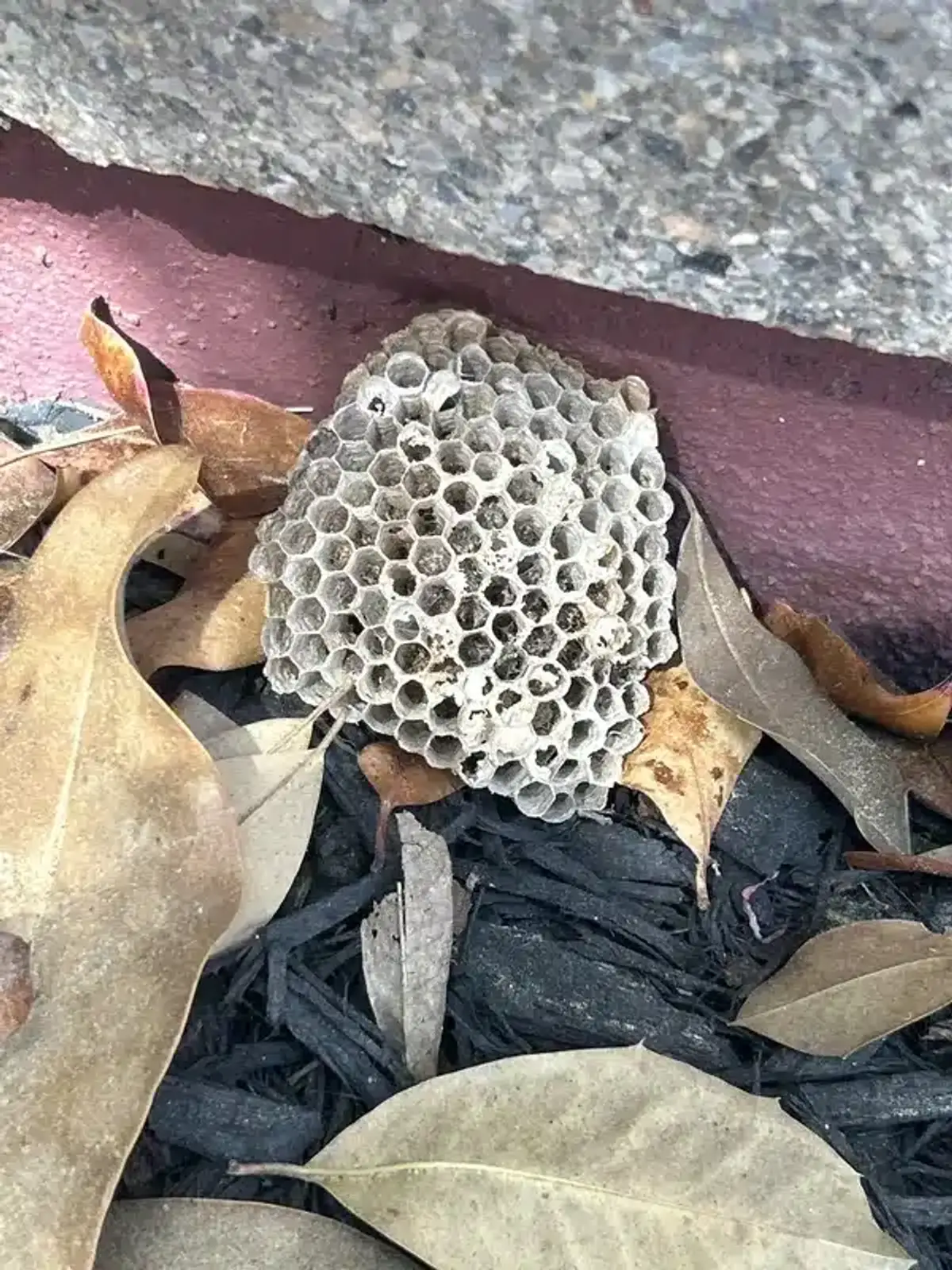
Unlike yellow jacket colonies that die off completely each winter, some paper wasp species (particularly the European variety) may reuse nests for multiple seasons. This makes early detection and removal especially important for long-term control.
Behavioral Patterns and Aggression Levels
Understanding aggression differences in the yellow jacket vs paper wasp debate can help you respond appropriately to encounters. These behavioral patterns become particularly important during late summer when colony populations peak.
Yellow Jacket Behavior
Yellow jackets exhibit highly defensive behavior, especially when protecting their nests. They release alarm pheromones that recruit nestmates to attack perceived threats. During my experience treating these insects, I’ve observed that their defense threshold drops significantly as colony sizes increase and food sources become scarce in late summer.
Emergency room visits from yellow jacket stings peak dramatically during late summer months, when colony populations reach their maximum size and food sources become scarce.
What does the science say?
According to University of Maryland Extension, yellow jacket sting incidents in emergency rooms peak during August and September, a period researchers have termed “autumn yellow jacket delirium.” This phenomenon occurs because colonies reach maximum population size (up to 5,000 workers) while natural food sources decline, making yellow jackets more aggressive and likely to seek human food sources.
Paper Wasp Behavior
Paper wasps generally display more predictable defensive behavior. They typically “warn” intruders by flying close or bumping before stinging. While they can deliver multiple stings and cause allergic reactions, they’re less likely to coordinate mass attacks compared to yellow jackets.
These wasps usually sting only when their nest or individual insects are directly threatened. This makes them somewhat more manageable around outdoor living spaces, though caution remains essential.
Safety Warning
Never attempt to remove active wasp nests yourself, especially yellow jacket ground nests. The defensive behavior of these social wasps intensifies dramatically when their colony is threatened, leading to multiple stings and potential medical emergencies.
Seasonal Activity and Social Wasp Life Cycles
Both species follow similar annual cycles, but understanding their timing helps with identification and management strategies. Overwintered queens begin establishing new colonies in March and April throughout Virginia and Maryland.
Worker populations reach their peak during August and September, when human encounters become most frequent. Late-season colonies can grow to substantial sizes, making them increasingly dangerous to approach.
What does the science say?
Virginia Cooperative Extension research documents that late-season colonies can exceed 5,000 individuals for yellow jackets or 200 for paper wasps. These peak populations occur when multiple generations of workers have been produced throughout the summer, creating the largest and most defensive colonies of the year.
During spring, wasp nests are extremely common when pollinators are most active. I’ve observed heightened aggressiveness again at the end of summer, particularly in August, making this period especially challenging for homeowners.
Beneficial Aspects of These Social Wasps
Despite their reputation as pests, both yellow jackets and paper wasps provide significant ecological benefits that homeowners should consider before deciding on removal.
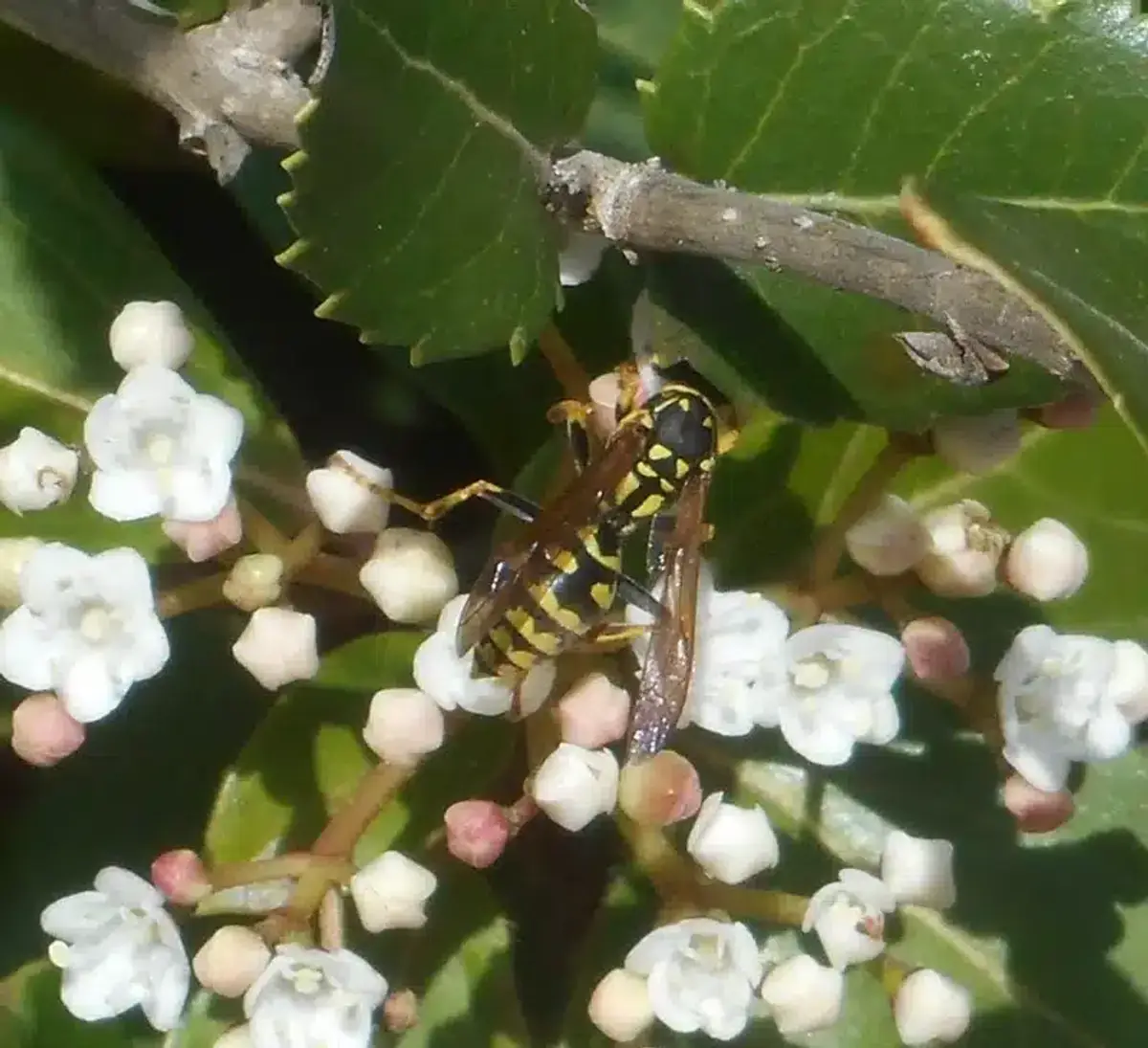
Both species are voracious predators of soft-bodied insects including caterpillars, sawfly larvae, and flies. Ohio State University Extension reports that a single yellow jacket colony can remove thousands of pest larvae during one season.
Paper wasps are often favored by vegetable gardeners for controlling loopers and hornworms. Additionally, both species visit flowers for nectar, providing secondary pollination services that benefit local plant communities.
Yellow Jacket vs Paper Wasp Removal Methods
When nests pose threats to people, understanding proper removal techniques for each species becomes crucial. The approach varies significantly based on nest location and insect behavior patterns.
Early Season Prevention
For paper wasps, you can safely knock down or scrape off starter nests smaller than golf balls during April, before first workers emerge. Founding queens usually abandon treated sites rather than rebuild.
Monthly scouting of structures and shrubs from May through July helps locate yellow jacket burrows or wall voids before populations explode into dangerous levels.
Professional Treatment Approaches
Based on my experience with these removal jobs, we always use protective equipment when approaching any active nest. For the underground yellow jacket colony I mentioned earlier, our approach involved spraying treatment at intervals into the nest, monitoring for activity, then returning days later to excavate the dead colony.

Treatment timing is critical for both species. We perform treatments at night or pre-dawn when temperatures drop below 55°F and most workers remain in the nest. This approach maximizes contact with the colony while minimizing risk to technicians and residents.
For aerial nests, we use specialized aerosol products designed to penetrate nest envelopes or reach open paper wasp combs. Underground yellow jacket colonies require dust applications that force contact as insects move through treated tunnels.
When to Call Professionals
Several situations warrant professional intervention rather than DIY attempts. These include nests inside wall voids, extremely large colonies, residents with known allergies, or removal needed near schools or playgrounds.
Sometimes homeowners encounter nests that appear abandoned after natural die-offs, and those can usually be knocked down with a broom. However, if you’re unsure whether a nest remains active, professional assessment prevents dangerous mistakes.
Prevention Strategies for Virginia and Maryland Homes
Preventing future yellow jacket vs paper wasp problems requires understanding what attracts these insects to residential areas. Both species seek protein sources during worker-production phases and sugar sources during late-season reproductive periods.
Key prevention steps include repairing soffit screens, sealing conduit gaps, and installing tight-fitting trash can lids. Removing fallen fruit from around fruit trees eliminates attractive food sources that draw foraging workers.
For areas prone to yellow jacket ground nests, maintaining well-drained soil and filling abandoned rodent burrows reduces available nesting sites. Paper wasp prevention focuses on eliminating attachment points under eaves and in sheltered structural areas.
Essential Prevention Steps
- Seal Entry Points: Repair damaged soffit screens, seal conduit gaps, and close off wall voids where wasps might nest
- Eliminate Food Sources: Use tight-fitting trash can lids, clean up fallen fruit promptly, and avoid leaving pet food outdoors
- Remove Nesting Sites: Fill abandoned rodent burrows, maintain proper drainage, and trim vegetation away from structures
- Early Detection: Scout your property monthly from April through July to catch new nests before they become established
Understanding Regional Yellowjackets and Social Wasps in the Mid-Atlantic
Virginia and Maryland host several species of both yellow jackets and paper wasps, each with slightly different behaviors and preferences. Common yellow jacket species include the eastern yellow jacket (Vespula maculifrons), German yellow jacket (V. germanica), and the aerial baldfaced “hornet” (Dolichovespula maculata).
Paper wasp species in our region include native Polistes fuscatus and P. exclamans, plus the invasive European paper wasp (P. dominula). Virginia Tech Extension notes that the European species may reuse nests across multiple seasons, unlike native varieties that build new nests annually.
Understanding these regional variations helps with accurate identification and appropriate management strategies. Each species responds differently to environmental conditions and control methods.
Health Considerations and Wasp Sting Allergic Reactions
Both yellow jackets and paper wasps can sting repeatedly because their stingers lack barbs, unlike honey bees. This capability makes encounters with either species potentially serious for sensitive individuals.
According to medical research, approximately 0.5 to 3 percent of U.S. adults experience systemic allergic reactions to wasp stings. Anyone with confirmed allergies should carry epinephrine auto-injectors and avoid areas with known nest activity.
Even non-allergic individuals can experience significant reactions from multiple stings, particularly from aggressive yellow jacket colonies. This reinforces the importance of professional removal for large or problematic nests.
The experiences I’ve had with these stinging insects have shown me firsthand how important proper identification and removal techniques are for yellow jackets and paper wasps around homes in Virginia and Maryland. Each species requires different approaches based on their unique behaviors and nesting preferences.
If you’re dealing with stinging insects around your property and need professional identification or removal services, don’t hesitate to call us at 703-683-2000 or email info@bettertermite.com. Our licensed technicians can assess your situation and recommend the most appropriate treatment approach for your specific circumstances.
Frequently Asked Questions
How can I tell if a nest is from yellow jackets or paper wasps?
+
Yellow jacket nests are enclosed with a paper envelope and typically found underground or in wall voids, while paper wasp nests are open umbrella-shaped combs attached to eaves, branches, or other structures. The open hexagonal cells of paper wasp nests are always visible from below.
Which is more aggressive: yellow jackets or paper wasps?
+
Yellow jackets are generally more aggressive, especially when defending their nests. They release alarm pheromones that recruit nestmates for coordinated attacks and become increasingly defensive as colony sizes grow during late summer. Paper wasps typically give warning flights before stinging and are less likely to mass-attack.
When is the best time to remove wasp nests in Virginia and Maryland?
+
The best time for removal is early season (April) when paper wasp nests are small and can be knocked down before workers emerge. For established nests, professional treatment should occur at night or pre-dawn when temperatures are below 55°F and most workers are present in the nest.
Are yellow jackets and paper wasps beneficial insects?
+
Yes, both species provide significant ecological benefits as predators of pest insects. A single yellow jacket colony can remove thousands of caterpillars, flies, and other pest larvae during one season. Paper wasps are particularly valued by gardeners for controlling hornworms and loopers on vegetables.
Can I remove a wasp nest myself?
+
Small paper wasp nests (golf ball size or smaller) can sometimes be safely removed in early season before workers emerge. However, established nests of either species pose significant sting risks and should be handled by licensed professionals with proper protective equipment and specialized insecticides.
Do yellow jackets and paper wasps reuse nests?
+
Most species build new nests each year, but the invasive European paper wasp (Polistes dominula) may reuse nests across multiple seasons. Yellow jacket colonies typically die off each winter and start fresh nests the following spring.
With five years of hands-on experience in the pest control industry, George Schulz is a registered technician with the Virginia Pest Management Association and a proud third-generation professional in a family business that's been protecting homes for over 57 years. He manages and trains a team of service pros while also leading internal research efforts—recently spearheading a deep-dive review of thousands of documents on pest control materials to hand-pick the most kid and pet friendly, most effective solutions tailored specifically for homes in the DC metro area.
